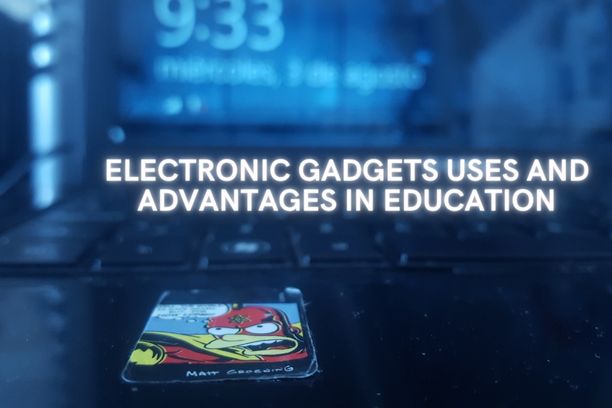
Electronic devices have made their way into students’ classroom learning processes in the age of connectivity and technology. These resources have been used to develop and enhance teaching strategies for pupils. Tablets, phones, and cameras are the gadgets that students use most frequently.
These electronic gadgets contribute to the rise in student expectations. When existing technology are employed in education, tasks and teamwork are made easier.
Improves pupils’ all-around performance.
Devices enhance both the effectiveness of teaching strategies and students’ learning potential. The use of electronic devices in the classroom has generally increased the flexibility of the activities. The numerous features and potentials of classroom technology also support the smooth transition of instructional methodologies, activating all of the senses in students.
Enables a student-centered educational approach.
Student-centered tactics are a staple of conventional teaching methods. Learning has strayed from this focus, though, as a result of changes in instructional methods and the accessibility of technology in the classroom. Electronic devices support and enhance student-centered learning by adding features that encourage participation in the classroom.
Enhances knowledge retention.
A key indicator of how well students are learning in class is retention. Because of this, utilizing technology in the classroom could improve students’ memory recall by engaging their many senses.
Improves the way lectures are delivered and presented.
Through the use of technology in the classroom, students have access to audio-visual and media presentations, which are now also portable. Content is no longer delivered using conventional techniques like boards, paper drawings, and outmoded black-and-white projectors.
Using electronic devices, instructors and students can personalize the way that material is presented in class. These techniques frequently increase students’ participation in class.
Increases teamwork.
Students cooperate more frequently in the classroom as a result of the distinctive and diverse roles that technology plays, particularly in terms of interest and involvement in classes.
Flexible learning is made possible by technology, as was already mentioned. This can be most clearly apparent in online conversations, exercises, and virtual classrooms, where technology’s capabilities and usability encourage voluntary collaboration in a similar way that they encourage it when compared to traditional learning techniques.
The use of electronic devices can improve communication, listening, and creative abilities. Preschoolers and toddlers learn through listening to music or viewing shows on television or portable devices. Their senses are stimulated by the visual portrayal.
Electronic device gaming competitions help to develop hand-eye coordination.
Without any help, students can better understand ideas by using learning apps.
Students might benefit from electronic devices in many different ways. Here are some examples of the various ways kids and students use them for good. Why not look through these ideas to assist you keep your kids engaged without electronics and support their learning while you read about the benefits and drawbacks of gadget use for kids?
Children can develop their problem-solving abilities by using educational toys. They are also useful for helping young children learn concepts like shapes, colors, and numbers.
Tech Tools Encourage Independent Learning
Nowadays, independent learning is encouraged since it allows pupils to learn without teacher support. Today’s students conduct their research online and complete their assignments using online databases. Therefore, using technology to enhance learning is incredibly beneficial for pupils.
When you want to keep your kids entertained away from digital screens, games for kids such various board games, classic strategy games, etc. are fantastic tools. Communication is made possible through devices like tablets, cellphones, and computers connected to the Internet. Email, chats, and group conversations are all feasible. Students are using their electronic devices more and more to collaborate on projects, make reports, and share chores and information.
Learning: To make learning easier for kids of all ages, there are a lot of educational videos and learning programmes online. Students can access a variety of educational apps on their electronic devices, including ones for language learning, home tutoring, and studying. Research: For students who spend a lot of time online conducting research, accessing journals, books, or periodicals, and participating in virtual classrooms, electronic gadgets are a blessing.
Improves Interaction
Additionally, people used to converse using letters, but today they may use their smartphones. Whatsapp, Twitter, Instagram, Facebook, and other social media platforms are now used for communication and have facilitated people’s lives.
Technology has completely changed how we work, play, shop, and communicate. They are a constant in contemporary life, but they are not without drawbacks. The negative effects of electronic devices, such as addiction, are getting more attention. Every user of electronic gadgets needs to be conscious of how they affect both society and our own life.
A gadget is a small, frequently inventive or new equipment or device. The most prominent examples of electronic devices are smartphones and tablets. These gadgets have evolved over the past several years into increasingly multifunctional tools that may be used for calling, streaming movies, and playing games. E-book readers, smartwatches, digital fitness trackers, GPS devices, and gaming consoles are more types of electronic devices. When addressing the benefits and drawbacks of gadgets, some people also mention monitors, laptops,
The fact that technological devices make our life easier is one of its greatest advantages. Anyone who lived in the era before mobile phones can tell you how difficult it was to locate a pay phone when you needed to call someone when you were away from home. By giving us access to email, text messaging, phone calls, video chat, and social media, gadgets assist us in maintaining our personal and professional connections. They help us establish new relationships both online and offline. Electronic gadgets have transformed the way that people shop, enabling internet
Technology can expedite work
Today’s technology has made life easier for pupils. This is because technology supports pupils’ productive work. For instance, pupils are capable of doing any kind of academic task quickly. Additionally, you can rapidly contact your friends and family with the aid of these devices.
Increasing Collaboration
Due to the numerous uses of technology in the classroom, student collaboration and involvement in class have increased. This is because flexible learning is now possible thanks to electronic devices.
These are the advantages of technology devices for students nowadays, to sum up. Students might thus improve their educational goals thanks to these benefits.



